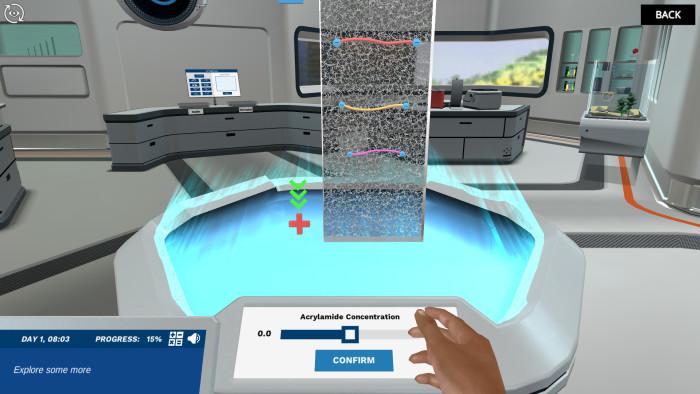
You want the best for your students, but microbiology lab budgets are getting smaller, and some lab equipment and supply costs are way out of budget. Even if one machine is on the less expensive side, scaling to provide equipment for your entire classroom or even multiple classes can prove to be costly.
What if you could access state-of-the-art microbiology science equipment for all your students without spending tons of money? Labster’s virtual simulations offer the chance to learn about and play with expensive equipment from the comfort of your classroom or students’ homes.
Here are five types of microbiology science lab equipment students can use with Labster that they likely cannot access in bulk in the classroom.
PCR is used in microbiology labs to detect and identify specific microorganisms by amplifying their DNA or RNA. It is also utilized for genetic characterization, allowing researchers to study variations and traits associated with microorganisms. Additionally, PCR enables quantitative analysis, helping to determine the amount of a particular microorganism in a sample.
Not only do thermal cyclers or PCR machines inconveniently take up a ton of time, but they also can be pricey. They run between $2,000- well over $10,000 for one machine.
In Labster’s virtual lab, Polymerase Chain Reaction, students will get a chance to learn the techniques and application of Polymerase Chain Reaction and Gel Electrophoresis. They’ll explore a real-world application, such as analyzing unique genetic fingerprints to solve a murder case.

An ELISA (Enzyme-Linked Immunosorbent Assay) kit is a laboratory test used to detect and measure antibodies or antigens in a sample. ELISA kits are often used to test for the presence of viruses, bacteria, and proteins in a sample. Centrifuges are also needed in the experiment, machines that apply centrifugal force to their contents.
ELISA kits can run about $750 - $3,000, and centrifuges can be anywhere from $300 - $6,000. These prices may not seem outrageous, but once you start to think about scaling, the cost becomes unwieldy.
In our virtual lab, ELISA, students will join scientists using this groundbreaking technique for detecting and quantifying substances, such as proteins. They’ll also help Dr. Lisa quantify Factor IX protein, which is used for hemophilia drugs.

A colony counter is a device used in microbiology to count and analyze bacterial or fungal colonies that grow on agar plates. These devices help researchers and technicians in quantifying the number of colonies present on a plate, which can be useful for determining bacterial concentrations in a sample or assessing the effectiveness of antimicrobial agents.
Colony counters are about $2,000, again making them challenging to scale in a microbiology lab.
In our virtual lab, Bacterial Quantification by Culture, students will learn how to quantify bacteria using the process of serial dilution. They’ll also calculate the cfu/ml from colonies counted on an agar plate, given the dilution factor and volume correction factor.
Gel electrophoresis is a widely used technique in microbiology and molecular biology for separating and analyzing DNA, RNA, and proteins based on their size and charge. It involves the movement of charged molecules through a gel matrix under the influence of an electric field.
There are several pieces of equipment needed to perform gel electrophoresis. Just the real time electrophoresis system can run $1,200. That doesn’t include the gel trays, formulas, and other accessories needed to run the experiment.
In our virtual lab, SDS-PAGE: Separating proteins by molecular weight, students will learn how SDS, the acrylamide gel, buffer solutions, and the electric current work together to separate proteins. Whereas normal gel electrophoresis can take upward of 3 hours, this can be done in under an hour!

A microbiological incubator is a piece of laboratory equipment used to provide a controlled environment for the growth and cultivation of microorganisms. It creates optimal conditions such as temperature, humidity, and often controlled levels of carbon dioxide (CO2) for the growth of bacteria, fungi, yeast, and other microorganisms.
Microbiological incubators can cost anywhere from $1,000 - $2,500. If you have a big class with lots of students, this can get costly and take up a lot of space.
In our virtual lab, Aseptic Technique: Culture your sample without contamination, students get the chance to use an incubator. They’ll help a microbiologist prepare a pure culture that can be used to identify a microbe causing an infection! They should use good aseptic technique to avoid contamination of the sample, ensure their own safety, and avoid surprise fires in the lab.

Virtual lab simulations aren’t meant to replace an in-person lab completely; they’re intended to supplement what you already have and give students access to a million-dollar lab they wouldn’t otherwise be able to try.
You want to equip your students with the best knowledge and experience they can get. With our catalog of over 300 simulations, we can help you do that at a lower price than you would pay to maintain expensive machinery and supplies.

Labster helps universities and high schools enhance student success in STEM.
Request DemoRequest a demo to discover how Labster helps high schools and universities enhance student success.
Request Demo